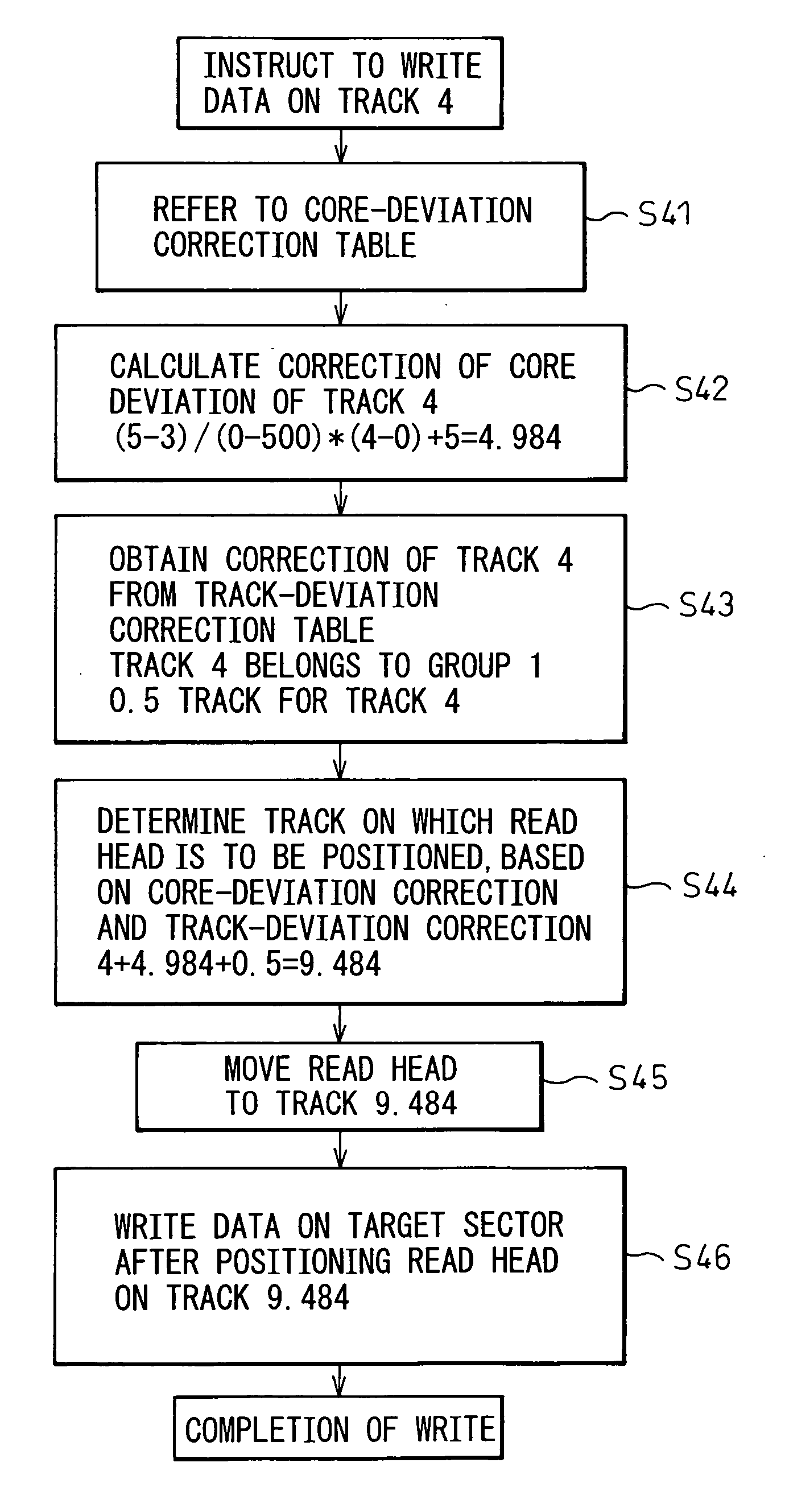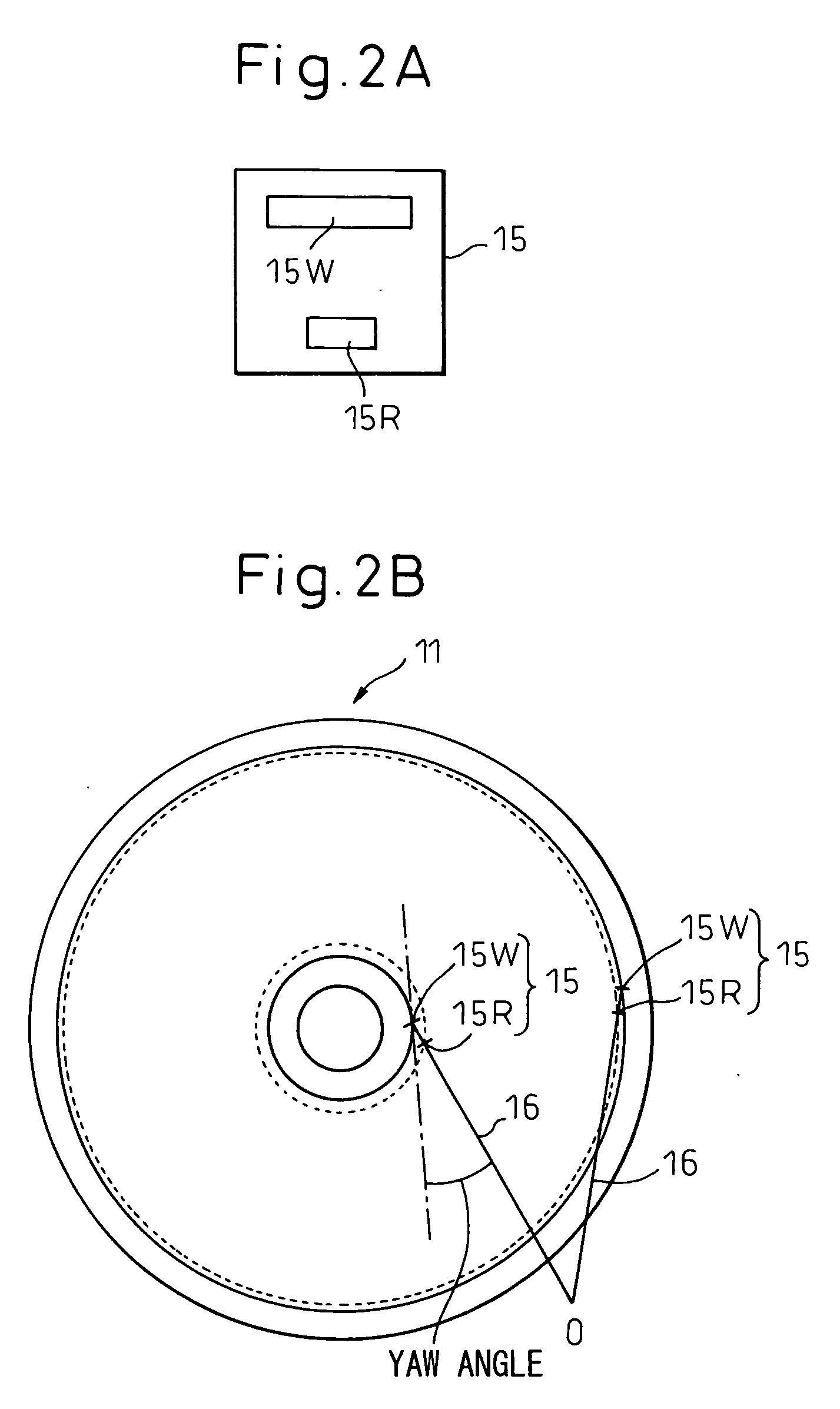Magnetic storage device and method of correcting magnetic head position
- Summary
- Abstract
- Description
- Claims
- Application Information
AI Technical Summary
Benefits of technology
Problems solved by technology
Method used
Image
Examples
example 1
Writing of Data Into Track 4
[0083]FIG. 6 shows an operation flow for writing data on track 4. When an instruction to write data on track 4 is given, the core-deviation correction table (FIG. 4A) is first referred to obtain the correction of core deviation of track 4 (step S41). The core-deviation correction table is stored in a nonvolatile memory such as a flash memory or a system region of a hard disc. Track 4 is not registered in the core-deviation correction table. Therefore, the correction of core deviation of track 4 is obtained by a linear interpolation (step S42).
[0084] In other words, track 4 is positioned between track 0 and track 500. The correction of core deviation of track 0 is five tracks, and the correction of core deviation of track 500 is three tracks. Therefore, the correction of core deviation of track 4 is obtained as follows.
[(5−3) / (0−500)]×(4−0)+5=4.984
[0085] Next, the correction of track deviation of track 4 is read from the track-deviation correction table (...
example 2
Data Reading From Track 4
[0088]FIG. 7 shows an operation flow for reading data from track 4. Unlike the data write operation, the data read operation does not require correction of core deviation. Therefore, when a data read instruction is given, the track-deviation correction table is referred to. Then a group number corresponding to track 4 is read from the track-deviation correction table (FIG. 4B) (step S51). Track 4 corresponds to group 1.
[0089] Next, correction of track deviation is calculated, and a track on which the read head is to be positioned is calculated. In this case, track 4 belongs to the group 1 and there is clearly no group that requires correction of track deviation before the group 1. Therefore, the correction of track deviation is zero (step S52).
[0090] Consequently, the read head is moved to track 4, without requiring correction of track deviation (step S53), and data is read from a sector of the target track after the read head is positioned on track 4 (ste...
example 3
Data Writing Into Track 7
[0091]FIG. 8 shows an operation flow for data writing into track 7. When an instruction to write data on track 7 is given, the core-deviation correction table (FIG. 4A) is first referred to obtain the correction of core deviation of track 4 (step S71). Track 7 is not registered in the core-deviation correction table. Therefore, the correction of core deviation is obtained by a linear interpolation (step S72).
[0092] In other words, track 7 is positioned between track 0 and track 500. The correction of core deviation of track 0 is five tracks, and the correction of core deviation of track 500 is three tracks. Therefore, the correction of core deviation of track 7 is obtained as follows.
[(5−3) / (0−500)]×(7−0)+5=4.972
[0093] Next, the correction of track deviation of track 7 is read from the track-deviation correction table (FIG. 4B) (step S73). The correction of track deviation of track 7 is the deviation 0.5 track of the group 1, because track 7 is in between t...
PUM
 Login to View More
Login to View More Abstract
Description
Claims
Application Information
 Login to View More
Login to View More - R&D
- Intellectual Property
- Life Sciences
- Materials
- Tech Scout
- Unparalleled Data Quality
- Higher Quality Content
- 60% Fewer Hallucinations
Browse by: Latest US Patents, China's latest patents, Technical Efficacy Thesaurus, Application Domain, Technology Topic, Popular Technical Reports.
© 2025 PatSnap. All rights reserved.Legal|Privacy policy|Modern Slavery Act Transparency Statement|Sitemap|About US| Contact US: help@patsnap.com



